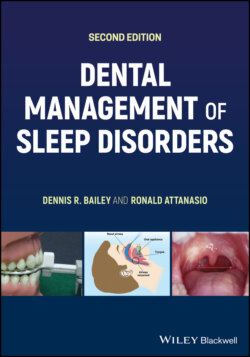Читать книгу Dental Management of Sleep Disorders - Ronald Attanasio - Страница 57
Normal Respiration
ОглавлениеA brief discussion and review of respiration needs to be addressed. Under normal circumstances respiration is mostly considered to be involuntary. It is primarily under the control of the diaphragm that is innervated by the phrenic nerve, composed primarily of muscle fibers that cause contraction. The phrenic nerve is derived from the cervical nerves at the C‐3 to C‐5 level. During passive breathing the diaphragm contracts and moves downward causing an increase in the negative pressure within the lungs and the alveoli. This negative pressure causes air to enter the lungs to fill them. In addition, this action may be impacted by the action of the intercostal muscles as well as the scalenes. Expiration during quiet breathing is passive and there is no active muscle activity. The process is related to the elastic recoil of the lungs and the rib cage.
Forced inspiration and expiration is different. With forced or exertional inspiration the scalenes and the sternocleidomastoid (SCM) muscles are active. They impact the first and second ribs as well as the sternum, and this results in the elevation of the bony cage in an effort to increase lung volume. Forced expiration is primarily an action of the intercostal muscles that pull the thoracic cage inward and force air out of the lungs.
Figure 3.1 Evolution of SRBD based on the acquisition of speech and the loss of the epiglottic‐soft palatal lockup. This allows the tongue base to occupy more of the oropharynx.
